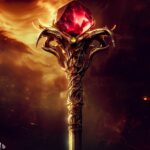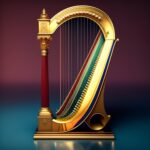The gods of the Áes Camáir bear powerful magical artifacts, and occasionally grant avatars of these relics to favored mortal champions.
Four of these relics, known as the Four Blessings, are the most powerful. Other relics are known as the Lesser Gifts, but they remain more powerful than anything a modern mage could create.
The Four Blessings
The Four Blessings are four powerful artifacts possessed by the Áes Camáir. From time to time, their avatars may also simultaneously exist on the prime material plane. Each is semi-sentient, but communicates cryptically through dreams, visions, and emotional projection rather than vocalized words. Each has a primary form but is also known to manifest in alternate forms as well. The gods will sometimes allow mortals to bear one of the blessings (and, extraordinarily rarely, perhaps two of them, but no one has ever been known to have more than two). The Blessings will only attune to someone of good intent whom the gods approve of, though this need not be someone who worships the Áes Camáir. The gods may grant use of one of the Four Blessings for a time – an individual quest, or an ongoing mission for the gods. Sometimes the Blessing is delivered to the mortal by one of the four winds. Other times, the gods may send dreams and visions to the mortal instructing them on where to find it. But the gods can be capricious, and someone who possesses one of the Blessings may find themselves challenged by a supernatural entity to reprove their worthiness, or it might simply disappear if the possessor has angered the gods or fulfilled their mission.
Once attuned, the relics generally cannot be taken from their possessor except when given away, taken back by the gods, or through death. The attuned possessor can always cause the relic to teleport back to him or herself from any distance, even across planes. Those who possess a relic age much more slowly than usual, though once they no longer possess the relic, they will begin to age normally from that point forth.
 Also called the Blade of Airgdide Gérat, the Fáebar dé Gérat generally manifests as a great sword whose silver blade crackles with a blue-white electrical energy. It may also manifest as a spear, an arrow, or other piercing weapon. It is associated with the god Airgdide Gérat, the element of air, and the east wind Anair ap Gáeth. For its authorized bearer, it confers the power of flight, whether held or sheathed. Wielders are automatically immune to lightning and electrical-based damage, whether from the weather, spell, breath weapons, or other sources, and the blade also grants the bearer the ability to cast certain lightning-based spells.
Also called the Blade of Airgdide Gérat, the Fáebar dé Gérat generally manifests as a great sword whose silver blade crackles with a blue-white electrical energy. It may also manifest as a spear, an arrow, or other piercing weapon. It is associated with the god Airgdide Gérat, the element of air, and the east wind Anair ap Gáeth. For its authorized bearer, it confers the power of flight, whether held or sheathed. Wielders are automatically immune to lightning and electrical-based damage, whether from the weather, spell, breath weapons, or other sources, and the blade also grants the bearer the ability to cast certain lightning-based spells.
 The Gablán dé Brigga, sometimes called the Rod of Ítharnae, belongs to the goddess Brigga ap Ítharnae but is often depicted being wielded by her son, Imbas Dúil. It generally manifests as a wizard’s staff but may also appear from time to time as a scepter, a wand, a shepherd’s crook, or similar rod-like object. It is associated with the element of fire and the south wind Faitse ap Gáeth. Those who wield it are granted immunity to all fire-based damage, including magical fire, dragon’s breath, and supernatural flames like on the Elemental Plane of Fire.
The Gablán dé Brigga, sometimes called the Rod of Ítharnae, belongs to the goddess Brigga ap Ítharnae but is often depicted being wielded by her son, Imbas Dúil. It generally manifests as a wizard’s staff but may also appear from time to time as a scepter, a wand, a shepherd’s crook, or similar rod-like object. It is associated with the element of fire and the south wind Faitse ap Gáeth. Those who wield it are granted immunity to all fire-based damage, including magical fire, dragon’s breath, and supernatural flames like on the Elemental Plane of Fire.
 The Croccán dé Túirenn generally appears as a cauldron but can also manifest as a chalice, grail, or similar vessel for liquids. It is primarily associated with the goddess Bráenna ap Túirenn, but also with Íarus ap Gáeth, the west wind. The person attuned to the cauldron can ladle from it an unlimited amount of hearty stew or water. In addition, they can use the cauldron to instantly create potions that heal injuries, cure diseases, neutralize poisons, and grant vitality. It is said that mages who use the cauldron to brew other potions can do so faster and with a reduced cost.
The Croccán dé Túirenn generally appears as a cauldron but can also manifest as a chalice, grail, or similar vessel for liquids. It is primarily associated with the goddess Bráenna ap Túirenn, but also with Íarus ap Gáeth, the west wind. The person attuned to the cauldron can ladle from it an unlimited amount of hearty stew or water. In addition, they can use the cauldron to instantly create potions that heal injuries, cure diseases, neutralize poisons, and grant vitality. It is said that mages who use the cauldron to brew other potions can do so faster and with a reduced cost.
 Ordae Ruíri wears a great golden crown known as the Lía dé Ordae. It can take the same form on the prime material plane but can also manifest as a helmet, hat, circlet, or other head covering. It is associated with the element of earth and the north wind, Túaiscert ap Gáeth. It is said to grant the wearer immunity from being charmed, petrified, poisoned, or magically frightened, and also grants heightened resistance to hostile enchantments. The crown also grants the bearer the ability to communicate in any tongue, and improves their insight, perception, and persuasiveness. While wearing the crown, the bearer is able to scry across great distances.
Ordae Ruíri wears a great golden crown known as the Lía dé Ordae. It can take the same form on the prime material plane but can also manifest as a helmet, hat, circlet, or other head covering. It is associated with the element of earth and the north wind, Túaiscert ap Gáeth. It is said to grant the wearer immunity from being charmed, petrified, poisoned, or magically frightened, and also grants heightened resistance to hostile enchantments. The crown also grants the bearer the ability to communicate in any tongue, and improves their insight, perception, and persuasiveness. While wearing the crown, the bearer is able to scry across great distances.
The Lesser Gifts
The Lesser Gifts are Áes Camáir artifacts that while not as powerful as the Four Blessings are nevertheless very mighty indeed.
 The Óirlúit generally appears as a golden harp, though it may appear as any musical instrument desired. Though not one of the Four Blessings, it is a very powerful relic in its own right, particularly when used by bards. Though it is not specifically named after him, many legends depict it being used by Gentraige Fín or delivered to a worthy mortal by him. Its strings cannot break, and it is said when a bard uses it to weave a spell, their spells are more powerful and more abundant. Some legends depict it as being used by Gwytheon, the mythical composer of the The Ádairiad sagas.
The Óirlúit generally appears as a golden harp, though it may appear as any musical instrument desired. Though not one of the Four Blessings, it is a very powerful relic in its own right, particularly when used by bards. Though it is not specifically named after him, many legends depict it being used by Gentraige Fín or delivered to a worthy mortal by him. Its strings cannot break, and it is said when a bard uses it to weave a spell, their spells are more powerful and more abundant. Some legends depict it as being used by Gwytheon, the mythical composer of the The Ádairiad sagas.
 The Seodaghrian is a fist-sized crystal that floats about the bearer when it is not hidden or being carried. It emits a bright light unless commanded not to, granting the bearer improved perceptiveness as well as the ability to see magic and sometimes pierce through illusions and magical disguises. It is not associated with any of the gods in particular, and unlike the other Áes Camáir relics, it is believed that it need not be granted by the grace of the gods but rather can be found by happenstance. Some believe that there may be more than one.
The Seodaghrian is a fist-sized crystal that floats about the bearer when it is not hidden or being carried. It emits a bright light unless commanded not to, granting the bearer improved perceptiveness as well as the ability to see magic and sometimes pierce through illusions and magical disguises. It is not associated with any of the gods in particular, and unlike the other Áes Camáir relics, it is believed that it need not be granted by the grace of the gods but rather can be found by happenstance. Some believe that there may be more than one.

